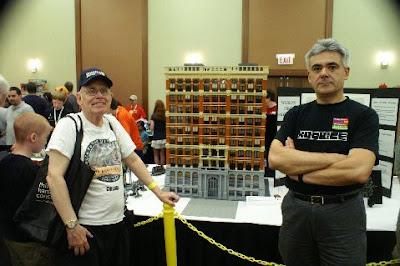click images for larger view
It's always difficult to imagine the architecture of the past as it actually appeared to people in its time. When it comes to the Chicago of the late 19th century, that past, now mostly wiped from the cityscape, passes through the desaturating black-and-white photographic record. Later photos may be more plentiful, but they usually depict buildings substantially altered from their original design.
We also see architecture of that time through the backward lenses of mid-century modernism, which emphasizes the simplicity of the commercial architecture of what has now been classified as the first Chicago School, seeing it as a precursor to the minimalist modernism of the International Style and the Second Chicago School of Mies van der Rohe and his followers.
But Louis Sullivan won't let you get away with it. The beautiful simplicity of his Carson Pirie Scott store is anchored by an entrance floor marked by huge shop windows enveloped by the rich, foliate ornament for which Sullivan was famous. His interiors, especially, were anything but austere, rich with stenciling, often designed with collaborators Louis J. Millet and George Healy, some of which, in a not uncontroversial restoration, was on display at a
Crown Hall exhibition at few years back.
Adler and Sullivan's 1891
Schiller/Garrick Theater is a case in point. Not only was the building itself tragically demolished in 1961, it's original interior design was painted over just seven years after the theater's opening.
As part of the new exhibition
Wright's Roots, at the Expo 72 Gallery at 72 East Randolph through September 30th, 2012. curator and Chicago Cultural Historian Tim Samuelson endeavored to reveal, for the first time in over a century, the original color scheme of the ornament above the balcony, on the underside of the gallery.
Architectural finishes analyst Robert Furhoff was provided a rescued sample of the ornament, on which he burrowed down all the later paint jobs to document the original color palette.
Erin McNamara executed a sculptural repair of the original, made a mold of the repair and cast new pieces. Anthony Kartsonas of Historic Surfaces LLC, who you see with Samuelson in the video below, then recreated the original paint pattern, using Furnoff's analysis. And last Friday, Tim Samuelson was kind enough to let us be a witness as, for the first time in nearly 114 years, the original colors were again revealed.
The walls on which Wright's Roots is mounted are painted in the colors of that palette.
Of course, the Victorian palette can take some getting used to - one observer at Friday's unveiling commented it wasn't a palette they would want to paint any part of their home with - but to truly get a feeling of what the experience of an Adler and Sullivan building was like, it's invaluable to be able to imagine being immersed in the colors of the original design.
A substantial part of
Wright's Roots traces the early, formative years when young Frank Lloyd Wright worked under the direction of Louis Sullivan, the man for whom he never lost his deep admiration and affection. Wright's hand can still be seen in many of Adler and Sullivan's buildings of that period, and Samuelson painstakingly lays out key examples.
The decorative panel you see above came from a Chicago apartment building built for Adolph and William Loeb in 1892. It was rescued by Samuelson, hanging upside-down from the roof, just before the structure was demolished. The apartments were attributed, rightly, to Adler and Sullivan, but as Samuelson relates . . .
When shown a photograph of the this long-forgotten project by architectural historian Richard Nickel in 1957, the ninety-year-old Frank grew momentarily quiet and then said, "So . . . you found THAT one, did you?" After another pause, he said the design was his.
Another piece of ornament that didn't make it into W
right's Roots documents the different route Frank Lloyd Wright would take from that of his mentor Louis Sullivan.
In the above photo from the
Chuckman Collection of the Garrick Theater under demolition, notice the large rectangular lozenges forming the outermost part of the arch. (The flat, white interior surfaces of the rectangles were originally a nine-part stencil.) Notice the border around each lozenge. It was designed by young Frank Lloyd Wright, and this is what it looked like . . .
This is about as far from Sullivan's style of ornament as you can get. Rigidly geometric, it has a vaguely Mayan feel that seems to anticipate Wright's later work.
There are a lot more fascinating stories in
Wright's Roots, which we hope to write about in more detail (famous last words) soon. Needless to say, it's a don't-miss event. See it, and let your own imagination run free.

















































